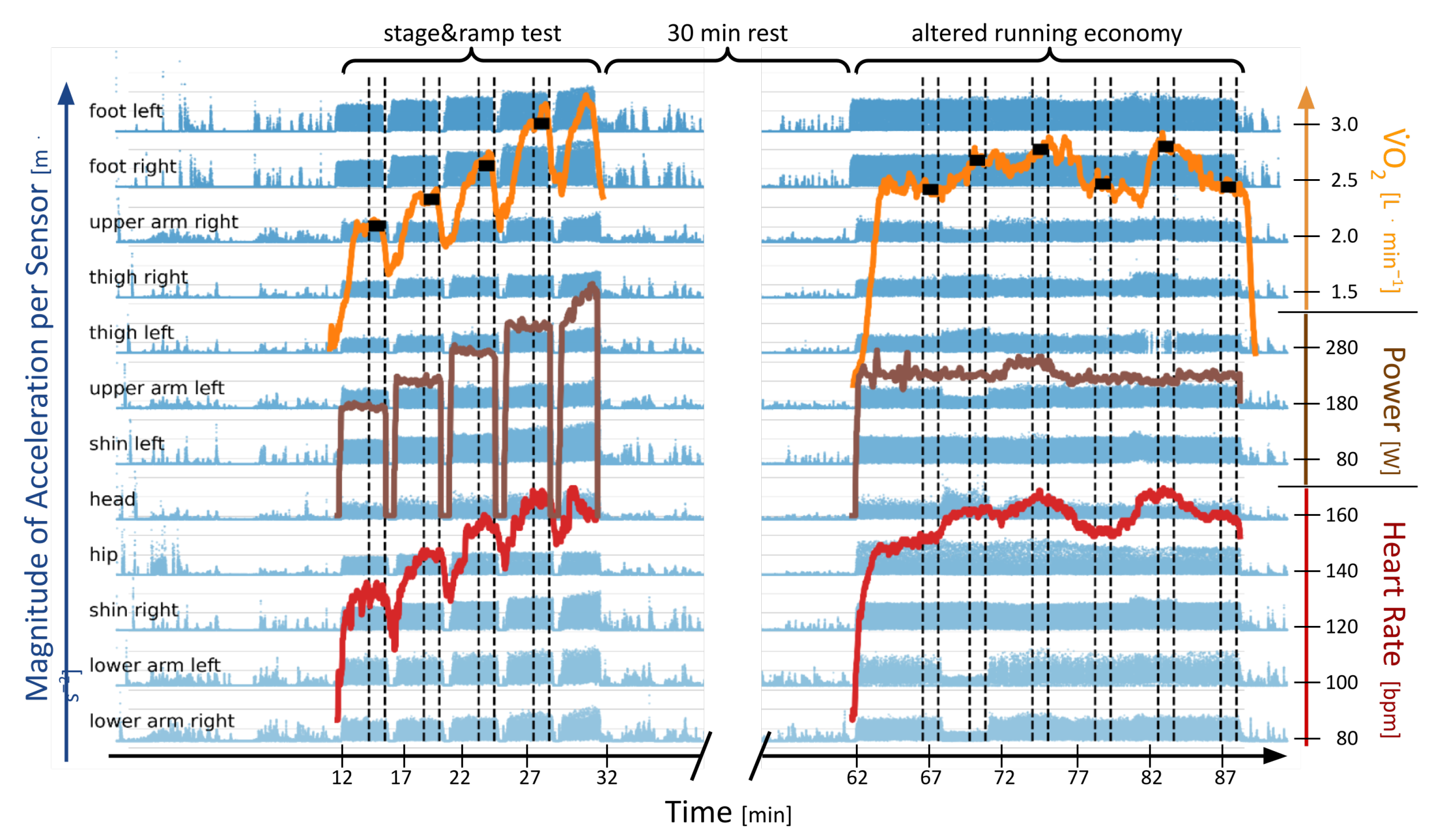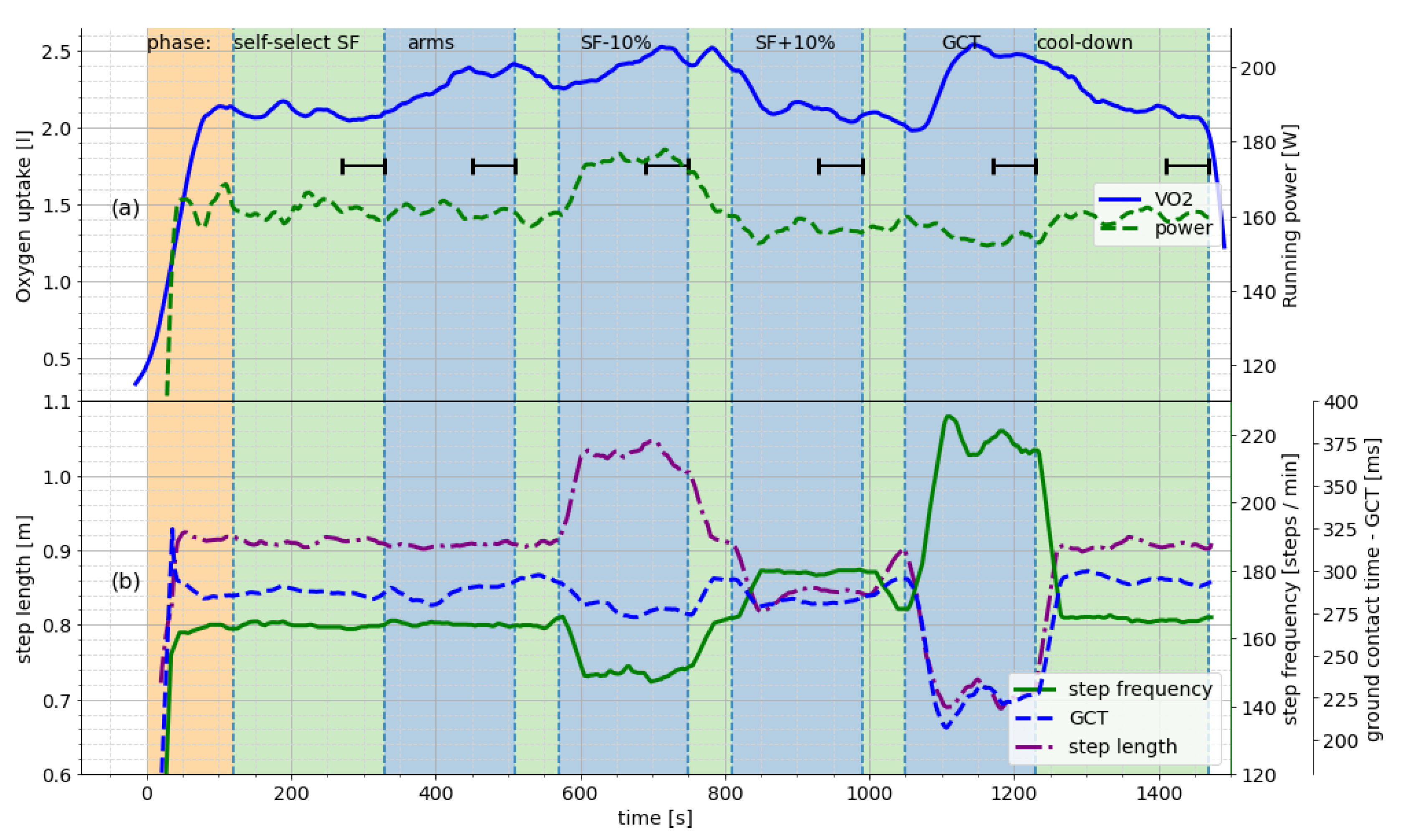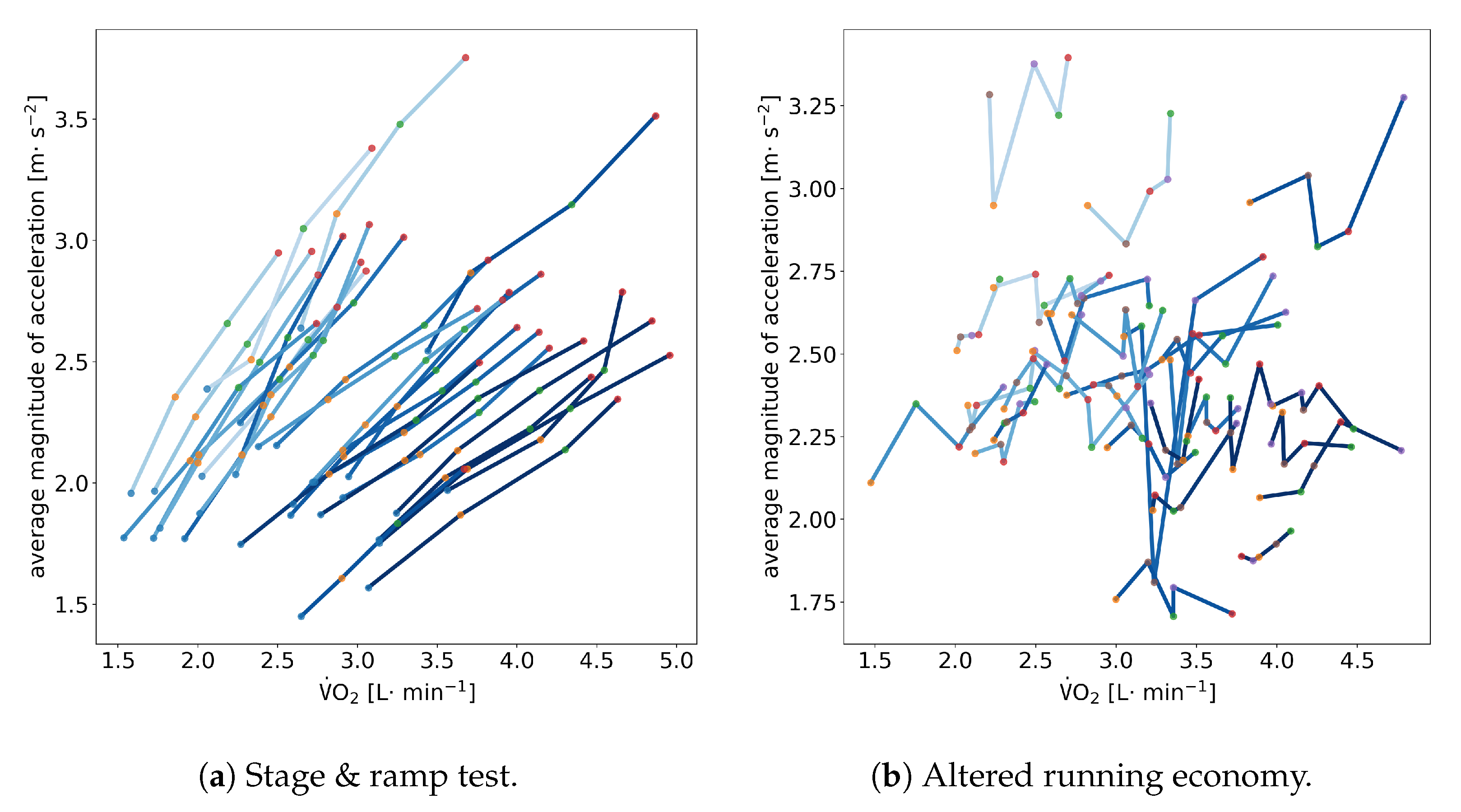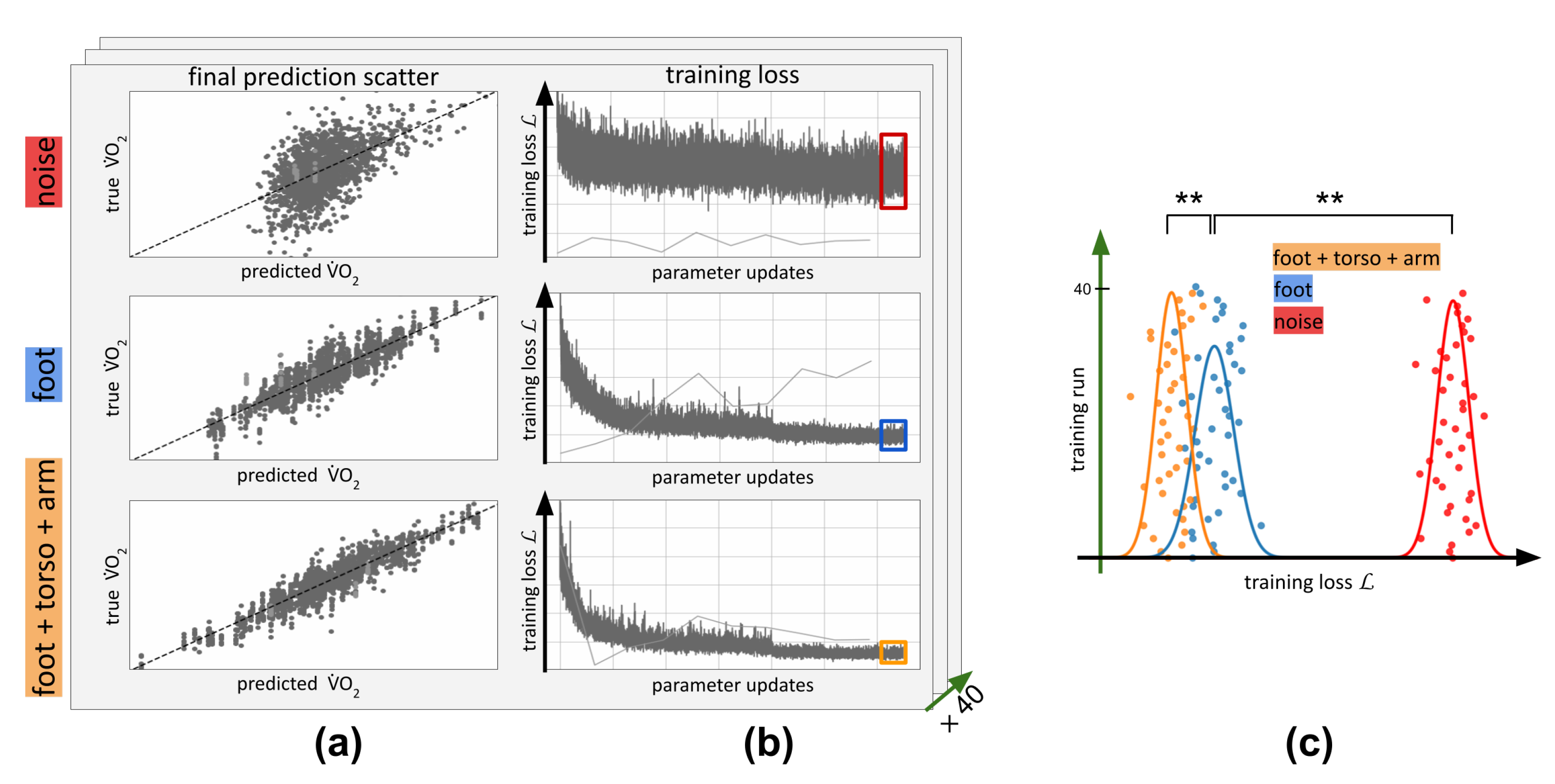Revealing the Mutual Information between Body-Worn Sensors and Metabolic Cost in Running
Abstract
1. Introduction
2. Materials and Methods
2.1. Subjects and Testing Procedure
2.2. Accelerometer Data
2.3. Relation between Energy and Sensors
2.4. Extracting Information
2.4.1. Deep Learning Model
2.4.2. Indirect Proof of Mutual Information Content
3. Results
4. Discussion
4.1. Limitations
4.2. Future Work and Extensions
5. Conclusions
Author Contributions
Funding
Institutional Review Board Statement
Informed Consent Statement
Data Availability Statement
Acknowledgments
Conflicts of Interest
References
- Tjelta, L.I. Three Norwegian brothers all European 1500 m champions: What is the secret? Int. J. Sport. Sci. Coach. 2019, 14, 694–700. [Google Scholar] [CrossRef]
- Soulard, J.; Vaillant, J.; Balaguier, R.; Baillet, A.; Gaudin, P.; Vuillerme, N. Foot-Worn Inertial Sensors Are Reliable to Assess Spatiotemporal Gait Parameters in Axial Spondyloarthritis under Single and Dual Task Walking in Axial Spondyloarthritis. Sensors 2020, 20, 6453. [Google Scholar] [CrossRef]
- Huang, Y.; Jirattigalachote, W.; Cutkosky, M.R.; Zhu, X.; Shull, P.B. Novel Foot Progression Angle Algorithm Estimation via Foot-Worn, Magneto-Inertial Sensing. IEEE Trans. Biomed. Eng. 2016, 63, 2278–2285. [Google Scholar] [CrossRef]
- Falbriard, M.; Meyer, F.; Mariani, B.; Millet, G.P.; Aminian, K. Accurate Estimation of Running Temporal Parameters Using Foot-Worn Inertial Sensors. Front. Physiol. 2018, 9, 610. [Google Scholar] [CrossRef]
- García-Pinillos, F.; Roche-Seruendo, L.E.; Marcén-Cinca, N.; Marco-Contreras, L.A.; Latorre-Román, P.A. Absolute Reliability and Concurrent Validity of the Stryd System for the Assessment of Running Stride Kinematics at Different Velocities. J. Strength Cond. Res. 2021, 35, 78–84. [Google Scholar] [CrossRef]
- Scataglini, S.; Cools, E.; Neyrinck, J.; Verwulgen, S. An Exploratory Analysis of User Needs and Design Issues of Wearable Technology for Monitoring Running Performances. Adv. Intell. Syst. Comput. 2021, 1206, 207–215. [Google Scholar] [CrossRef]
- Ettema, G.; Lorås, H.W. Efficiency in cycling: A review. Eur. J. Appl. Physiol. 2009, 106, 1–14. [Google Scholar] [CrossRef]
- Barnes, K.R.; Kilding, A.E. Running economy: Measurement, norms, and determining factors. Sport. Med.-Open 2015, 1, 1–15. [Google Scholar] [CrossRef]
- Muniz-Pardos, B.; Sutehall, S.; Gellaerts, J.; Falbriard, M.; Mariani, B.; Bosch, A.; Asrat, M.; Schaible, J.; Pitsiladis, Y.P. Integration of Wearable Sensors into the Evaluation of Running Economy and Foot Mechanics in Elite Runners. Curr. Sport. Med. Rep. 2018, 17, 480–488. [Google Scholar] [CrossRef]
- Seiler, S.; Tønnessen, E. Intervals, thresholds, and long slow distance: The role of intensity and duration in endurance training. Sportscience 2009, 13, 1–27. [Google Scholar]
- Baumgartner, T.; Held, S.; Klatt, S.; Donath, L. Limitations of Foot-Worn Sensors for Assessing Running Power. Sensors 2021, 21, 4952. [Google Scholar] [CrossRef]
- Janssen, M.; Walravens, R.; Thibaut, E.; Scheerder, J.; Brombacher, A.; Vos, S. Understanding different types of recreational runners and how they use running-related technology. Int. J. Environ. Res. Public Health 2020, 17, 2276. [Google Scholar] [CrossRef]
- Wasserman, D.H. Four grams of glucose. Am. J. Physiol.-Endocrinol. Metab. 2009, 296, E11–E21. [Google Scholar] [CrossRef]
- Kreitzman, S.N.; Coxon, A.Y.; Szaz, K.F. Glycogen storage: Illusions of easy weight loss, excessive weight regain, and distortions in estimates of body composition. Am. J. Clin. Nutr. 1992, 56, 292S–293S. [Google Scholar] [CrossRef]
- Jeukendrup, A.E. Nutrition for endurance sports: Marathon, triathlon, and road cycling. In Food, Nutrition and Sports Performance III; Routledge: Oxfordshire, UK, 2013; pp. 99–108. [Google Scholar] [CrossRef]
- Joyner, M.J. Modeling: Optimal marathon performance on the basis of physiological factors. J. Appl. Physiol. 1991, 70, 683–687. [Google Scholar] [CrossRef]
- Hagan, R.; Strathman, T.; Strathman, L.; Gettman, L. Oxygen uptake and energy expenditure during horizontal treadmill running. J. Appl. Physiol. 1980, 49, 571–575. [Google Scholar] [CrossRef]
- Mayhew, J. Oxygen cost and energy expenditure of running in trained runners. Br. J. Sport. Med. 1977, 11, 116–121. [Google Scholar] [CrossRef]
- Snyder, K. Running Power Definition and Utility. 2020. Available online: https://blog.stryd.com/2020/12/17/running-power-definition-utility-article/ (accessed on 19 May 2021).
- Willems, P.; Cavagna, G.; Heglund, N. External, internal and total work in human locomotion. J. Exp. Biol. 1995, 198, 379–393. [Google Scholar] [CrossRef]
- How to Lead the Pack: Running Power Meters & Quality Data. 2017. Available online: https://blog.stryd.com/2017/12/07/how-to-lead-the-pack-running-power-meters-quality-data/ (accessed on 19 May 2021).
- Morgan, D.; Martin, P.; Craib, M.; Caruso, C.; Clifton, R.; Hopewell, R. Effect of step length optimization on the aerobic demand of running. J. Appl. Physiol. 1994, 77, 245–251. [Google Scholar] [CrossRef]
- de Ruiter, C.J.; Verdijk, P.W.; Werker, W.; Zuidema, M.J.; de Haan, A. Stride frequency in relation to oxygen consumption in experienced and novice runners. Eur. J. Sport Sci. 2014, 14, 251–258. [Google Scholar] [CrossRef]
- Goodfellow, I.; Bengio, Y.; Courville, A. Deep Learning; MIT Press: Cambridge, MA, USA, 2016; Available online: http://www.deeplearningbook.org (accessed on 31 January 2022).
- Tishby, N.; Pereira, F.C.; Bialek, W. The information bottleneck method. arXiv 2000. [Google Scholar] [CrossRef]
- Lehmann, M.; Berg, A.; Kapp, R.; Wessinghage, T.; Keul, J. Correlations between Laboratory Testing and Distance Running Performance in Marathoners of Similar Performance Ability. Int. J. Sport. Med. 1983, 4, 226–230. [Google Scholar] [CrossRef]
- Midgley, A.W.; McNaughton, L.R.; Polman, R.; Marchant, D. Criteria for Determination of Maximal Oxygen Uptake. Sport. Med. 2007, 37, 1019–1028. [Google Scholar] [CrossRef]
- Moore, I.S. Is There an Economical Running Technique? A Review of Modifiable Biomechanical Factors Affecting Running Economy. Sport. Med. 2016, 46, 793–807. [Google Scholar] [CrossRef]
- Barnes, K.R.; Kilding, A.E. A Randomized Crossover Study Investigating the Running Economy of Highly-Trained Male and Female Distance Runners in Marathon Racing Shoes versus Track Spikes. Sport. Med. 2018, 49, 331–342. [Google Scholar] [CrossRef]
- Shannon, C.E. A mathematical theory of communication. Bell Syst. Tech. J. 1948, 27, 379–423. [Google Scholar] [CrossRef]
- Kreer, J. A question of terminology. IRE Trans. Inf. Theory 1957, 3, 208. [Google Scholar] [CrossRef]
- Cover, T.M.; Thomas, J.A. Entropy, relative entropy and mutual information. Elem. Inf. Theory 1991, 2, 12–13. [Google Scholar]
- Kingma, D.P.; Ba, J. Adam: A method for stochastic optimization. arXiv 2014. [Google Scholar] [CrossRef]
- Sárándi, I.; Linder, T.; Arras, K.O.; Leibe, B. MeTRAbs: Metric-Scale Truncation-Robust Heatmaps for Absolute 3D Human Pose Estimation. IEEE Trans. Biom. Behav. Identity Sci. 2021, 3, 16–30. [Google Scholar] [CrossRef]
- Chen, J.; Little, J.J. Sports camera calibration via synthetic data. In Proceedings of the IEEE/CVF Conference on Computer Vision and Pattern Recognition Workshops, Long Beach, CA, USA, 16–17 June 2019. [Google Scholar]
- Xie, K.; Wang, T.; Iqbal, U.; Guo, Y.; Fidler, S.; Shkurti, F. Physics-based Human Motion Estimation and Synthesis from Videos. In Proceedings of the IEEE/CVF International Conference on Computer Vision, Nashville, TN, USA, 19–25 June 2021. [Google Scholar]
- Li, S.; Xue, J.J.; Hong, P.; Song, C.; He, Z.H. Comparison of energy expenditure and substrate metabolism during overground and motorized treadmill running in Chinese middle-aged women. Sci. Rep. 2020, 10, 1815. [Google Scholar] [CrossRef]
- Bailey, J.; Mata, T.; Mercer, J.A. Is the relationship between stride length, frequency, and velocity influenced by running on a treadmill or overground? Int. J. Exerc. Sci. 2017, 10, 1067. [Google Scholar]
- McGillem, C.; Cooper, G. Continuous and Discrete Signal and Systems Analysis; Holt, Rinehart and Winston: New York, NY, USA, 1974. [Google Scholar]
- Vaswani, A.; Shazeer, N.; Parmar, N.; Uszkoreit, J.; Jones, L.; Gomez, A.N.; Kaiser, L.; Polosukhin, I. Attention is all you need. Adv. Neural Inf. Process. Syst. 2017, 30. [Google Scholar] [CrossRef]





Disclaimer/Publisher’s Note: The statements, opinions and data contained in all publications are solely those of the individual author(s) and contributor(s) and not of MDPI and/or the editor(s). MDPI and/or the editor(s) disclaim responsibility for any injury to people or property resulting from any ideas, methods, instructions or products referred to in the content. |
© 2023 by the authors. Licensee MDPI, Basel, Switzerland. This article is an open access article distributed under the terms and conditions of the Creative Commons Attribution (CC BY) license (https://creativecommons.org/licenses/by/4.0/).
Share and Cite
Baumgartner, T.; Klatt, S.; Donath, L. Revealing the Mutual Information between Body-Worn Sensors and Metabolic Cost in Running. Sensors 2023, 23, 1756. https://doi.org/10.3390/s23041756
Baumgartner T, Klatt S, Donath L. Revealing the Mutual Information between Body-Worn Sensors and Metabolic Cost in Running. Sensors. 2023; 23(4):1756. https://doi.org/10.3390/s23041756
Chicago/Turabian StyleBaumgartner, Tobias, Stefanie Klatt, and Lars Donath. 2023. "Revealing the Mutual Information between Body-Worn Sensors and Metabolic Cost in Running" Sensors 23, no. 4: 1756. https://doi.org/10.3390/s23041756
APA StyleBaumgartner, T., Klatt, S., & Donath, L. (2023). Revealing the Mutual Information between Body-Worn Sensors and Metabolic Cost in Running. Sensors, 23(4), 1756. https://doi.org/10.3390/s23041756





